Frequently Asked Questions (FAQs) about Climate Change
- What is Climate Change?
- Is Climate Change the Same Thing as Global Warming?
- Is it Really Caused by People?
- Can We Trust the Scientists? What if it's a Conspiracy?
- Isn't Climate Change Normal? What About Ice Ages, Sun Spots and Things Like That?
- How Good are the Climate Forecasts? It's Tough Just to Predict the Weather.
- What is a Ton of CO2? Should I Care?
- What Is a Carbon Footprint? Do I have one?
- Will This Impact Me? When?
- How Much Hotter Will it Get?
- Won't a Warmer Earth be Better for Crops?
- This Feels Like a Long Term Problem. What's the Big Rush?
- I'm Just One Person. What Difference Can I Make?
- How Much Will it Cost Me? Can I Save Money?
- What's the Easiest Way to Make a Difference?
- Can We Save the Polar Bears? Isn't it Too Late?
- Where can I learn more?
What is Climate Change?
Climate is used to describe the long term patterns of rain, snow, hot, cold or humidity for a specific region or location. These patterns, which we often experience as seasonal changes, are typically repeated over decades and centuries, and are different from weather, which can change from day to day and week to week as fair weather and storms pass through. You can think of climate as the timing, duration and style of the seasons for a region; it is usually predictable and consistent, like the arrival of spring or fall conditions, or rainfall patterns for arid or tropical areas. You can think of weather as what is happening outside right now, or in the next few days. It's the usual ups and downs, fair weather or stormy, and is full of variability from natural causes.

Climate Change is used to describe the change in these long term patterns over time and recently to capture the idea they are human caused from our use of energy from fossil fuels like coal, oil and natural gas.
The gases that are produced by burning of these fuels (the same ones that come out of your car's tailpipe), are called greenhouse gases because once they're up in the sky they start warming the earth causing lasting shifts in seasonal variations and regional climate. It's also amplifying natural variability, leading to stronger storms, more intense heatwaves, stronger hurricanes and more record setting events in general. Of course there are natural forces that drive climate change, think of volcanic eruptions, which can have short term cooling effects, but these are often described as climate variability to keep them separate from human caused factors or Climate Change.
Is Climate Change the Same Thing as Global Warming?
Yes. Both are used to describe the importance of changes to the earth's climate from human driven changes to the atmosphere from greenhouse gas emissions.
This said, Climate Change is more descriptive because a whole lot more is happening than just increases in temperature, or warming, around the planet. Scientists are already documenting the predicted increases in many extreme events, including longer and more intense heat waves, increased precipitation (both rainfall and snowfall), the intensity of hurricanes, changes to animal environments (ecosystems), the oceans and much more.
C'mon, Is It Really Caused by People?
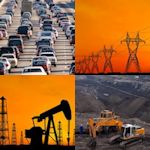
The scientific evidence that the planet is on a steep warming trend is beyond strong. The scientific debate as to whether it is human caused is also over. It is.
The rationale that it's human caused is supported by analysis that exhaustively estimates the magnitude of all other possible sources of warming based on well studied physical principles. Examples of these include possible impact from: sun cycles (solar radiation), volcanic activity and know effects of changes in the earth's orbit around the sun, the latter being over very long time scales. The bottom line is that none of these effects come close to the impact of human greenhouse gas emissions on warming in the past 50 years.
In addition, the basic principles from chemistry and physics, which explain why emissions of greenhouse gases into the sky cause Climate Change have been understood for over 100 years. There is simply no other explanation for the warming of the last 50 years.
Looking for the data that supports this...check out the " " page
Can We Really Trust the Scientists? What if It's all a Conspiracy?

Most of us trust our doctor for medical advice. Don’t we? We trust their knowledge and training in medicine. They went to medical school, they held internships, they studied biology, physiology and biochemistry (say what?). They know about heart disease, medicines, infections, how to heal broken bones, blood pressure, sore throats and all the rest.
What we don't think about is that almost all the treatments they prescribe are a result of the scientific method. Ultimately, it is science - the science of medicine - that allows our doctors to make diagnosis and write prescriptions with confidence. It's also true that many of the treatments they prescribe including: choice of medicine, how much to take, diagnostic tests to monitor recovery, and the type and duration of follow-up are backed up by something called consensus scientific opinion.
At the ClimateStore, we see no difference in the trust we place in our doctor at the clinic than that we place in experts atmospheric science, earth science, geophysics, chemistry, ecology, oceanography and the other disciplines that comprise the field of Climate Science.
Why? Because at the root of all these disciplines is something called the scientific method. The scientific method involves formulating and testing hypothesis, using data from carefully controlled experiments to generate results, and analysis rooted in physical principles to explain them. New discoveries require strong evidence and must survive the scrutiny and feedback of fellow scientists using a peer review process (i.e. review by other experts in the same field), prior to being accepted for publication. The scientific culture is built on skepticism, scrutiny, and debate among scientists.
But to reach a consensus scientific opinion you need even more. After a discovery is published, independent studies are undertaken that may either support or reject the original study. Only after multiple studies reach similar findings are new ideas widely accepted. And in both medicine and climate science, consensus reports are issued following critical review of the literature by panels of experts.
Is the process perfect? Of course not; but they are firmly grounded in the culture of science and the most rigorous we know.

At present, more than 97% of scientists in the climate science field agree that the world is unequivocally warming and that human activity is the primary cause of the warming experienced in the past 50 years. Given the culture of skepticism amongst scientists this widespread agreement is amazing! Scientists do not "believe" in human-induced climate change; they have reached a conclusion based on overwhelming evidence.
Oh, and about conspiracy theories? At the ClimateStore, we don’t’ give them a thought. Even when faced with overwhelming evidence, there will always be some who think it’s a hoax, that there must be some other motive lurking somewhere. They will never be swayed by new evidence; they have made up their minds. When the oceans rise 20 feet, they will claim it was an asteroid from their perch on the highest mountains.
Isn't Climate Change Normal? What About Ice Ages, Sun Spots and Things Like That?
It's true that the earth's climate is impacted by natural affects; this includes things like volcanic eruptions, variation in the output of the Sun's energy over time, slow changes in the geometry of the earth's orbit around the sun, changes in the amount of biomass (carbon sinks though forest growth and die back), the amount of ice cover in polar regions (it turns out it's pretty good at reflecting solar radiation back into space), and even (very) large meteor strikes. On time scales over tens of thousands of years, slow variations in the geometry of the earth's orbit around the sun have major impacts.
But although these natural factors have an affect, they only explain about 20% of recent warming. The remaining 80% of warming of the planet in the past 50 years is due to human released greenhouse gases into the atmosphere.
Changes in energy from the Sun are an important driver of the Earth’s climate. Data from ice cores, tree rings, and other evidence shows a link between global temperature and changes in solar output. Over the last 50 years, however, temperature change cannot be explained by changes in the energy from the Sun. Satellite measurements (in place since 1978), have measured a slight decrease in the Sun’s output. All told, the Sun can explain less than 10% of the increase in temperature since 1750, and none of the increase in temperature since 1960, when temperatures started to increase dramatically.

Large volcanic eruptions can also cool climate for a few years after an eruption. Particles from the eruption stay suspended in the atmosphere and can can scatter sunlight, cooling the Earth’s surface. Particles from large eruptions like Pinatubo in 1991 or Krakatoa in 1883 penetrated well into the stratosphere, where they stayed for several years. Eventually, they fall back to lower altitudes where they are rapidly removed by rain. Volcanoes also emit carbon dioxide, but this amount is less than 1% annually of the emissions occurring from human activities.
Natural factors are still affecting the planet’s climate today. The difference is that, since the beginning of the Industrial Revolution, humans have been adding increasing amounts of heat trapping gases to the atmosphere at a much faster rate than can occur naturally. Records from ice cores, tree rings, soil boreholes, and other forms of “natural thermometers,” or “proxy” climate data, reveal three important findings. First, recent climate change is unusually rapid. After a glacial maximum, the Earth typically warms by about 7ºF to 13ºF over thousands of years. The current rate of warming is about 8 times faster!
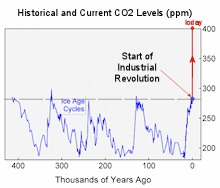
Second, global temperatures in the last 100 years are unusually high when compared to temperatures over the last several thousand years.
And third, carbon dioxide levels are currently higher than at any time in the last 800,000 years. Paleoclimate studies indicate that temperature and carbon dioxide levels have been higher in the distant past, millions of years ago, when the world was very different than it is today.
Never before have such rapid, global-scale changes occurred during the history of human civilization.
How Good are the Climate Forecasts? It's Tough Just to Predict the Weather.
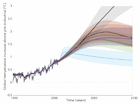
Good point. Although it's clear that human caused Climate Change is happening now, predicting what will happen in the future, like how much temperatures will increase and rainfall might change - 20 years from now! - is simply not a precise thing. There are a number of reasons for this. First, as we know, nature is complicated, although most of the physical principles driving climate change are understood, details still need to be worked out - for example, like the effect of cloud cover. Second, all models rely on assumptions, and in this case, this includes assumptions about how we humans will adapt to the coming changes - for example - how fast will we reduce emissions once we get aligned. And third, as these are large models, there are computer limitations related to the granularity of the answers.
The good news is scientists have improving climate models for over 50 years; and along the way, the data used to test them, like long term temperature records, tree ring data, ice cores, etc. has been improving. This is important because it has allowed for benchmarking using historical data. And this makes sense; models must do a reasonable job replicating the past before predicting the future - and they do.
In addition, knowing model results are imprecise, scientists spend hours refining and discussing something called confidence limits. It turns out it's not good enough to predict what the temperature might be 20 years from now, let say, in Chicago; you also need to estimate how confident you are this will occur. As you might expect, models have higher confidence about what will happen in the early years, let's say up to 10 years into the future, and decreasing confidence for longer time periods.
Also, because there are multiple research teams working on models, there is ongoing comparisons of methods and results in an attempt to understand and test assumptions and modeling approaches.
So the long and short of this is that although climate models are not precise tools, they are the only tool we have that allow us to peer into the future. And because their outputs are estimates, they come with different levels of certainty. By design, part of the scientific process is rigorous debate about the assumptions, interpretation and likelyhood that what the models are saying are true.
So although any single model results is not a basis of making change, when multiple models, bench marked against historical data are used, and challenged by experts in the field, they are both useful and important tools to estimate the regional impact of climate change in the future.
What the Heck is a Ton of C02?

One metric Ton of CO2
1 metric ton = 2,204 lbs
You may recall from school that a "ton" is a unit of weight. And it's a whole lot.
One ton is equal to 2,000 pounds (lbs) of something. That's the same weight as 238 gallons of milk (try loading that into your fridge), 2000 blocks of butter (4 sticks to a pack), or 400 sacks of flower (at 5 lbs each, it's enough to overflow the back of a pick-up truck). It's a lot of weight when you think about it. But it's also only a fraction of the weight of greenhouse gases the average U.S. citizen emits every year without even thinking about it. Yikes!
Now this is tricky to think about ...so stick with us. Let's start with the typical fill-up for your car. It takes about 10 gallons to fill the tank, and believe it or not, this weighs about 60 pounds. And if you drive a lot, after a week or so it's gone, time for another fill-up. Now where did all that gasoline go? Well is was burned in your engine to get you to and from your job, your school or maybe the beach, and the whole time, exhaust was coming out of your tailpipe.
Well the primary gas created from burning that (now gone) gasoline is called carbon dioxide or CO2. It's crystal clear, lightweight and is the same gas that fizzes your Coke or Pepsi. It's a by-product of burning gasoline (and coal and natural gas), and it goes up in the sky and is the cause of Climate Change.
So what does this have to do with a Ton of Carbon? Well, it turns out for every 10 gallons of gasoline you use (remember, that weighs ~60 pounds), you generate about 120 pounds of C02 gas. The increase comes from the chemistry of the reaction. We can skip the details for now, but suffice it to say there is more weight of C02 gas coming out of the exhaust pipe than liquid gas that was put in. It also means if you refill your car approximately 17 times (at 10 gallons a refill), you will have generated about 2,000 pounds of C02 gas! Welcome to the one Ton club! Most of us have been stellar members for years.
Well, given it's pretty hard to picture one Ton (2,000 lbs) of a lightweight gas, another way to think about it is it's volume equivalent. It's kind of like filling up a balloon or beach ball at a birthday party. Even though a gas is lightweight it occupies a large volume. Well, it turns out the volume that 2,000 pounds of C02 gas occupies is huge! It's as big as a house in some parts. And it's this gas that gets mixed with the existing oxygen and nitrogen and water vapor that comprises our sky and atmosphere.
According to the EPA, the energy required to support the average family home in the US generates is approximately 19,000 lbs of CO2 per year! That's 8.5 Tons of CO2 gas, all without seeing it (remember, it's crystal clear), hearing it (for the most part), or feeling it (i.e. knowing how heavy it is). In addition, 5 Tons more comes from a typical passenger vehicle.
It kind of makes your head spin, but there are some ways to think about it and visualize it. The following examples (again, from the EPA) are helpful:
- One metric ton of CO2 (a metric is a little more that an English ton), is released to the atmosphere for every 103 gallons of gasoline used. Using a car that gets 25 miles to the gallon, that’s just a bit more than 2,500 miles—about two months driving for many Americans.
- Using up 40 barbeque propane canisters is the equivalent of releasing a ton of carbon dioxide into the atmosphere.
- About 12 metric tons of CO2 are released to the atmosphere each year as a result of the energy consumed by the average American home for heating, cooling, cooking, electricity use, and other energy needs.
What is A Carbon Footprint? Do I Have One?
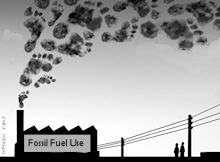
A Carbon Footprint is a way of quantifying the CO2 emissions that result from our daily activities and consumption of goods and services. Because just about everything we do requires energy, and most of that energy comes from fossil fuels, by default, we contribute to the generation of greenhouse gas emissions.
The most obvious source of our carbon footprint comes from direct use of energy, anything from turning on the lights, using the microwave, taking an elevator, or driving the car to the mall. Most of the "kick" required for those activities come from coal, natural gas or oil, and for each the required burning (also called combustion), to extract the energy results in CO2 emissions from an exhaust pipe, chimney or smokestack somewhere.
But there's more to it than just direct use of energy. Whether we realize it or not, all the stuff we buy requires energy to create and therefore adds to our carbon footprint.
Buying a new car is a good example. Long before it shows up on the lot, there is a trail of emissions linked to it's creation. Energy is required to create the basic materials (steel, plastics, glass, etc), to manufacture the parts, to ship the parts to assembly plants, to assemble the car, to paint and polish, and finally for shipping to the dealer. So long before you drive the first mile, your purchase has made an impact on the atmosphere.
And the same idea holds for food, consumables, clothing and so much more. Think about that the next time your walking through a WALMART. Which of the goods on the shelves has the biggest impact on climate change? Kind of mind bending when you think about it.
So your carbon footprint (measured in tons of C02), is the sum total of all the emissions you: (1) created as you used energy for activities (like power washing your deck or taking an elevator), (2) were generated to create the consumables (i.e. food and stuff) you purchased, or (3) emitted as a result of the services (like dry cleaning), you used....over one full year.
Most of us in North America have a Carbon Footprint of 8,000-12,000 lbs per year. It's a staggering amount...and we never even see the C02 gas that makes this up!
Will this Impact Me? When?
Climate Change will impact all of us - one way or another. But the magnitude and type of response will depend on where you live. And the severity of future impact will depend on how soon (and how much), we start reducing our carbon footprint. If we don't start acting soon, it could be quite severe in the years to come.
The impacts are not going to be uniform for all locations. In the US, models predict that the southwest and parts of the southeast will get dryer and the Midwest, southern great plains and northeast will get wetter.
But there will be many possible impacts. The average temperature in the US has increased by about 1.5 degrees F since 1895 and 80% of the increase (that's most if it!), has occurred since 1980. Rainfall amounts have shifted, heavy downpours are increasing in most regions of the US, especially over the past 30 to 50 years, further increases are projected.
Certain types of extreme weather events have become more frequent and intense. Heat-waves are predicted to be more intense and longer. And as more moisture is expected in a warming atmosphere, increased precipitation will lead to increased flooding in some areas. Extended and more intense droughts will lead to increased numbers of forest fires and pressure on water supplies.
There has been an increase in both the strength and number of strong hurricanes in the North Atlantic since the early 1980s. The intensity of the strongest hurricanes is projected to continue to increase as the oceans warm.
Winter storms have also increased slightly in frequency and intensity.
Other trends in severe storms, including the numbers of hurricanes and the intensity and frequency of tornadoes, hail, and damaging thunderstorm winds are uncertain and are being studied.
Global sea level has risen by about 8 inches since 1880. It is predicted to rise another 1 to as much as 4 feet by 2100.
Rising temperatures are reducing ice volume and extent on land, lakes and sea and this loss of ice is expected to continue.
The oceans are currently absorbing about 25% of the C02 that is emitted into the atmosphere annually and their chemistry is changing, leading to concerns about potential impacts on ocean species and their habitats.
Want to learn more? Take a look at some of the . They're packed with expert opinions about national and regional impacts.
How Much Hotter Will it Get?

No one knows exactly how hot our future summers could be. It depends on many factors, including where you live and how much we are able to reduce our emissions. But the majority of scientists agree there will be more extreme events including heat waves that will be longer and more severe. This means we can expect to continue to break records. Mostly on the hot side, but not always.
If we want to look for some examples, the heat wave in Texas in 2011, and the spring and summer of 2012 are telling. Research has found that the human contribution to climate change approximately doubled the probability of the record heat in Texas in the summer of 2011. So while the recent Texas heat waves and droughts could have occurred naturally, the likelihood of record-breaking temperature extremes has increased (and will continue to increase), as climate change progresses. The changes in climate are increasing the likelihood for severe events.
In 2012 we had the warmest March ever recorded in the US and the hottest summer. Part of the country had 70 days with temperatures hitting 100°F or more, again, hitting new duration records. During the summer of 2012/2013 in Australia, so many new records were set that they had to introduce new colors on their temperature maps. In the summer of 2010 the temperatures in Russia soared leading to a failure of the wheat crop. And in the summer of 2006 a heat wave in Europe led to new all time records. There is even a trend that summer nights aren't getting a cool as they used to.
And what's amazing is that even with all this heat, this could be just a signal of what's to come if we don't start reducing energy use from fossil fuels. Long term data suggests we have warmed the planet ~1.6°F above pre-industrial levels, and because CO2 emissions are the "gift that keep on giving" there is another 1.6°F already coming our way. All the more reason to start cutting emissions now.
Won't a Warmer Earth be Better for Crops?

It sounds reasonable that plants would do better in a warmer world! Plants require C02 to grow, so why wouldn't more food, through more CO2, and warmer growing conditions be a good thing?
Well, although it's true that some plants will grow faster, over the long term the impact of climate change on plants and agriculture is likely to be very negative.
It turns out that plants need a whole lot more than just warmth and CO2 to thrive. They also need the right amount of soil moisture and nutrients; they are sensitive to temperature extremes during times of pollination; they must defend against weeds and insects, which might get worse; they are impacted by the length of both dry and wet spells, as well as daytime and nighttime high temperatures; and some plants, like some fruit and nut trees, require a certain duration of cold spells in winter, which are already getting milder.
Increased precipitation in some areas will lead to excess moisture in soils and topsoil erosion. And there is evidence that some weeds may benefit more than crop plants from high C02, and are more resilient to existing pesticides. The list of challenges goes on and on.
Another important impediment that Climate Change causes is that it disrupts the pollination stage. Yes, that green powdery stuff, that gets all over your car and can aggravate allergies, has a role in our food suppy. Pollen is fundamental to the development and maturation of the many fruit, grain, and fiber species that we utilize. More head waves during this period of the plant growing cycle can reduce overall crop yield and weaken plants resistance to additional stresses. A recent example of this is how high nighttime temperatures in 2010 and 2012 caused premature budding in corn yields across the US Corn Belt.
One critical period is the pollination stage; pollen release triggers development of fruit, grain, or fiber. Exposure to high temperatures during this period can greatly reduce crop yields and increase the risk of crop failure. Also, plants exposed to high nighttime temperatures during the grain, fiber, or fruit production/filling period experience lower productivity and reduced quality. These effects have already begun to occur; corn yields were affected by high nighttime temperatures in 2010 and 2012 across the Corn Belt in the U.S., and with the number of nights with hot temperatures projected to increase as much as 30%, yield reductions will become more prevalent. Warmer winters can lead to early bud-burst or bloom of some perennial plants, resulting in frost damage when cold conditions occur in late spring.
Soil characteristics, on which plants depend, are also sensitive to changing climate conditions. Changes in soil carbon content and soil loss will be affected through changes in soil temperature, soil water availability, and the amount of organic matter input from plants. Increasing temperatures cause cultivated plants to grow and mature more quickly, which counter intuitively, causes plants to be smaller because soil may not be able to supply nutrients at required rates, thereby reducing overall seasonal growth and reducing grain, forage, fruit, or fiber production.
Crops have optimal temperature, moisture and soil conditions to which they have adapted. As regional climates shift, crop growth will be affected due to mismatches between the new growing conditions and a crop’s optimal range; and although in some cases crops can be shifted to accommodate changes in regional climate, due to their multiple environmental requirements (e.g. soil makeup, moisture content, pollination conditions, etc.), it's extremely unlikely this can be done for many species.
Climate disruptions to agricultural production have increased in the recent past and are projected to increase further over the next 25 years. By mid-century and beyond, these impacts will be increasingly negative on most crops and livestock. Many agricultural regions could experience declines in crop and livestock production from increased stress due to weeds, diseases, insect pests, and other climate change-induced stresses.
This Feels like a Long Term Problem, Why Do We Need to Act Now?
If we don't dramatically reduce our use of fossil fuels in the coming years the effect of climate change could be very severe. It turns out that CO2 emissions (the primary greenhouse gas that causes climate change), are the gift that keep on giving. Once it's up in the sky it hangs around literally for 100's of years doing its climate warming thing. We can't see it (it's crystal clear), but it's up there acting like a warming blanket for the earth. Not good.
In fact, it hangs around so long, you can see why even small additions could be problematic. The delayed - long term warming effect - of emissions (coupled with the time it takes to heat up the Oceans), is called the "lag" effect. And it's the primary reason we need to act immediately to reduce our energy use. It also means that capping emissions at current level is not sufficient. If we stay on the current path, there is a high risk that we could warm the planet well beyond levels that are consistent with sustaining life and ecosystems as we have known them. Yikes.
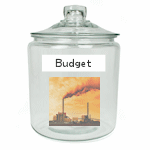
Because of the lag effect, we can now think in terms of having a budget for how much additional CO2 we can release into the atmosphere. Although it's a big number, by some estimates, we have already used more than half of our allotment in the past 100 years! Te reality is that for every additional ton of greenhouse gas we put up in the sky there is a permanent increase in global temperatures. And because we agree we can't exceed the 2°C red line, we can estimate how much CO2 we can emit before we cross the red line.
Current estimates put this cap at ~3700Pg CO2 to give us even odds of not crossing the 2°C line. Now this sounds like a lot, but it's not. Given we've emitted half of this amount to date (we've been doing lots of work and play the last 100 years), at our current high emissions levels we would hit this in 50 years! After that we could use no more. It's like (fossil fuel) lights out for 9+ billion people on the planet (or more). That's simply not going to happen.
To assure we don't cross the line, we need to start reducing significantly...today. If we start now we can reduce emissions at a manageable level (to be technical, 3.5% per year). If we delay, 5 or 10 years, it gets more and more difficult. If we don't start for another decade, it's unlikely we'll make it at all.
I'm Just One Person. What Difference Can I Make?
At the ClimateStore, we believe in the power of personal leadership. We believe that individuals, families and small communities can make a difference on Climate Change.
The science shows that by reducing your carbon footprint, you can make a long-lasting impact on the planet and its animals. Every single reduction made today mitigates warming this decade and beyond. Your reductions also offset emissions that might be locked-in somewhere until we can build, and others can gain access to, cleaner energy sources.

Margaret Mead
(1901-1978)
Now it's true that if we don't all get involved - meaning communities, towns, cities and whole countries - and soon - we increase the risk of significant climate change; and it's also true it will take time to change course because we can't all stop using fossil fuels tomorrow. But if we get started now and stay involved for the long haul, we can make our collective goal. And there's good news: .
It was Margaret Mead, the famous anthropologist and winner of the Presidential Medal of Freedom, who once said "Never doubt that a small group of thoughtful, committed citizens can change the world; indeed, it's the only thing that ever has". ....we couldn't agree more.
How Much Will This Cost Me? Can I Save Money?
Reducing you carbon footprint does not need to cost a lot of money. In fact, there are many things you can do that are free, and all will have an immediate impact (as examples: walk more for errands, don't idle you car when waiting, turn down the thermostat in winter, and nudge it up a bit in summer).
There are other things that will require a small initial investment, but that will save you money in the long haul - like installing a smart thermostat. Check out way to save money
What's the Easiest Way to Make a Difference?
The good news is that there are lots of easy ways to reduce your energy use and, in turn, reduce your carbon footprint....and the ClimateStore is here to help.
Check out our and pages for great ideas and recommended first steps.
Can we Really Save the Polar Bears? Isn't it too Late?
It's not too late to help the polar bears! If we start reducing our Carbon Footprint today, their future will be more secure. But we need to get started now and make steady progress going forward.
But the risk of not acting is severe. The amount of summer sea ice, which the polar bears need to hunt, has been shrinking due to climate change, and will continue to do so. But where it stops is up to us! If we cut our emissions drastically some forecasts suggest there will be enough habitat to support the Polar bears in the future.
If we do nothing, there is, sadly, a possibility they will become extinct.
At the ClimateStore, we don't think that this an acceptable outcome. So
.
Climate Change Resources - Where Can I Learn More?
There are many great sites that cover the science and policy issues related to Climate Change. Check out our Climate Change: The Details Page and Keep Informed: Consensus reports.
For more FAQs and to see the sources we used.
DRAFT report - US National Climate Assessment Development Advicoary Committee (NCADAC) Climate Assessment Report - 2013
IPCC, 2007: Climate Change 2007: The Physical Science Basis. Contribution of Working Group I to the Fourth Assessment Report of the Intergovernmental Panel on Climate Change [Solomon, S., D. Qin, M. Manning, Z. Chen, M. Marquis, K.B. Averyt, M.Tignor and H.L. Miller (eds.)]. Cambridge University Press, Cambridge, United Kingdom and New York, NY




